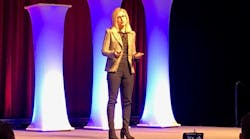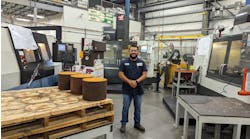Pittsburgh’s riverbanks used to be covered with steel mills—and soot. In the middle of the day, the street lights had to come on light up the city. Workers had to change their shirts at lunch, they got so dirty.
Just a few decades later, the city is a very different story. The riverbanks host bike trails and wooded parks. It’s a city of great transformation.
PPG, which began as Pittsburgh Plate Glass in the 1800s, has persisted and changed with the times as well, said Rebecca Liebert, senior vice president of Automotive Coatings for PPG. The opening keynote speaker at the 2019 IndustryWeek Manufacturing & Technology Conference this week, Liebert spoke about transforming manufacturing in a time of disruption.
In its early days, the glass company acquired a paint company and provided the paint for the Ford Model T. In 1963, it developed the technology to electro deposit coatings on metal surfaces, allowing automotive paint to have a much longer life. Now, PPG looking to the future in areas like clearer laminated windows for airplanes – “China needs 7,700 airplanes and wants to sell every window that goes into those airplanes,” says Liebert.
Consumer expectations are growing. With autonomous vehicles on the horizon, PPG is looking into the future with different coatings for Uber and Lyft vehicles, where passengers are constantly climbing in and out of the ride. With the lines being blurred between brick-and-mortar and e-commerce, even further into the future are architectural coatings for vehicles that might be used as traveling stores, restaurants, hotel rooms.
Liebert shared the four key areas she sees for leaders to manage through transformation:
1. Organization and Manufacturing Operating System: Get the right team on the bus and get each member in the right seat, she said, quoting Jim Collins, author of the management book Good to Great. Implement an MOS and the cadence that drives action.
Management should be focused on strategy, while still touching the continuous improvement and day-to-day management areas, said Liebert Many leaders spend too much time in day-to-day management. Have a work process in place that lets you spend more time on strategy—share action plans and document progress.
To keep the process improving, have regular performance discussions—both scheduled and impromptu feedback.
“Your cadence sets the business,” said Liebert. “Jack Welch said the worst thing you can do is fire someone at 55.” If you have to fire them, it’s because they’re in the wrong role and you haven’t given them feedback, she explained.
Also, it’s become even more important that your people develop deep expertise, not superficial knowledge, with the increased specialization that comes with technology and big data.
Too many leaders ask, “What if we invest and they don’t stay?” The real question should be, “What if we don’t invest and they stay?” Liebert said.
2. Markets and Customer: Know your markets better than the competition and your customers better than they know themselves.
B&B companies are good at value creation, but not very good at value capture. Usually the mindset is “We’re a B2B—We don’t’ set what our offering is.” A question leaders should be asking is how much value their product is worth than the next best alternative.
Value capture “is really not an academic exercise. PPG spends a lot of time on commercial strategy,” said Liebert “Thinking about what we’re making, takes a lot of work … To bridge value creation and value capture, it’s really important you know what your standard is.”
3. Processes and Technology: Drive process and technology development to advance your customers and markets, enabling everyone to make more money. Liebert used the example of Tom Brady throwing the same pass a thousand time over the course of a season—doing it over and over and perfecting it so it becomes second nature, leaving leadership more time for bigger things: strategy and decision-making.
Customer expectations are rising, so there’s no room for process mistakes. “It used to be OK to have a few defects,” she said. “Today the customer is really looking for zero defects.”
4. Productivity and Competitiveness: Do it more rapidly and effectively than the competition.“Raise the bar every single day,” said Liebert. Never accept your technologies or process are good enough.” One of PPG’s competitors put out a product that was superior to what they were offering. PPG caught up, but “now we’re only at parity. We can only sell at the same price point our competitor is selling at. If you’re the leader, you can set the price point. Why does Apple launch the iPhone 10? So they can be the leader and set the price point.”
Sears could have been Amazon—they had the distribution network and the ability to connect with the masses, but they didn’t innovate around their advantage. Kodak had the intellectual property for digital photography, but the chemical side of the company was so dominant that Kodak didn’t innovate in digital.





